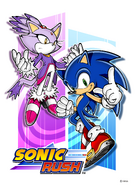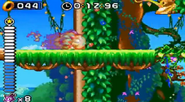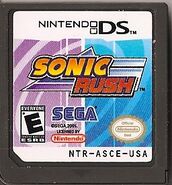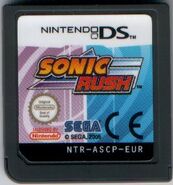|
Sonic Rush is the name of a game for the Nintendo DS. It was the first game of the Sonic franchise to be released on the DS. Sonic Rush capitalizes on the 'dual screen' aspect in three ways; one, it uses the two screens like one extended vertical screen, for very steep climbs and drops; two, the game centers on two parallel universes colliding; three, the game features two hero characters, Sonic the Hedgehog and a new character, Blaze the Cat. The sequel of the game is Sonic Rush Adventure.
The game is combination of 2D (for standard fights) and 3D (for boss battles). The stylus of the DS is largely unused, except in map mode and for special stages (special stages are only available in Sonic's story).
Story
The game's story centers around two characters in two alternate universes, Sonic and Blaze, as both try to save their worlds from colliding using the Chaos and Sol Emeralds. However, the more they obtain, the more their actions have a 'ripple effect' on the other world.
Gameplay
Sonic Rush is a 2D platform game, similar to earlier games in the series as well as later ones like Sonic Advance. In the tradition of past Sonic games, the player (playing as either Sonic the Hedgehog or Blaze the Cat) moves quickly through levels, collecting rings, items, and defeating enemies. The player collects rings as a form of health; when they are attacked by an enemy, their rings bounce in all directions. If they are hit by an enemy and have no rings, they lose a life. One different element of this game versus the original Genesis titles is that more more you get hit in a level, the farther your rings scatter. Both of the DS's screens are used to display the play area, with the player's character moving between them as necessary. Levels in the game are divided into "zones", each consisting of two acts of normal gameplay and a Boss battle. Although the game is primarily two-dimensional, there are three-dimensional elements which create a 2.5D effect. For the first time in the series, Sonic and Blaze's sprites are rendered in 3D. Boss battles—in which Blaze fights Doctor Eggman and Sonic fights an Eggman doppelgänger called Eggman Nega are also rendered in 3D. The special stage features Sonic running through a wide and very long three-dimensional half-pipe, collecting rings and hitting trick panels to meet requirements, with a goal of collecting Chaos Emeralds—colored jewels that are a central theme to the series. It is similar to the special stage of Sonic the Hedgehog 2. Sol Emeralds also appear as collectibles for Blaze, necessary to reach the final level, but Blaze collects these through boss fights and not through the Special Zone.
New features include a grading system that grades the player based on the time it takes for them to complete the level; they can return to levels later to try for a higher grade. There is a point system based on the one in Sonic Advance 2 but displaying points in multiple categories. There is also a "Tension Gauge" on the left side of the screen which is filled by doing tricks and defeating enemies. The energy it generates allows the player to use boosts of speed while moving; defeating enemies, moving through the level more quickly which results in more points and a higher grade, and when playing as Sonic, accessing the special stage.
Sonic Rush has a multi-player mode in which Sonic and Blaze race to the end of a chosen level from the game. There is also a feature in which players who own the game can send a demo of the game to other Nintendo DS users.
Plot
Blaze the Cat lands somehow in Sonic's world from her own dimension (unofficially dubbed the "Sol Dimension" by fans). She has seven Sol Emeralds—similar to the Chaos Emeralds—but they are stolen by Doctor Eggman. She then makes it her goal to retrieve them; this is where Sonic meets her (the Chaos Emeralds were stolen from him by Eggman Nega.) While she is searching for the Sol Emeralds, Sonic is searching for the Chaos Emeralds.
Blaze meets Cream the Rabbit, and is surprised by Cream's politeness. Meanwhile, Tails learns that Blaze's world and Sonic's are beginning to merge somehow. Sonic begins to grow suspicious of Blaze and, along with Tails, looks for her. Soon, Sonic and Tails find Blaze and Cream. Sonic questions Blaze about her nature, but she refuses to give any information and leaves with Cream. Sonic follows her, and when he meets her on Eggman Nega's base, it is revealed that Eggman and Eggman Nega are working together to collect both the Chaos Emeralds and the Sol Emeralds. She declares that she will destroy Eggman Nega. When Sonic once again questions her nature, she turns on him and fights him. During the fight, Blaze tells Sonic that she is the only one who can save their worlds, so he should not disturb her. However, Sonic wins the fight, and Blaze realizes the error of her ways. Eggman kidnaps Cream, and Blaze goes after him while Sonic takes on Nega. Blaze finds Cream in the wreckage of his mech and freely acknowledges to Cream that they are friends. Sonic notices this, but is alerted to Amy running towards him wielding a hammer by Knuckles, prompting him to run from her.
Sonic collects the last of the seven Chaos Emeralds and meets Blaze, who has lost the Sol Emeralds' power to Nega and failed to restore balance between the two worlds. Sonic and his friends help Blaze realize the meaning of friendship, and she turns into Burning Blaze apparently answering Sonic who turned into Super Sonic. They fight Eggman and Eggman Nega and defeat them. The two worlds are restored, Sonic and Blaze chat for a minute about how they will miss one another especially Cream who will miss Blaze. Blaze tells Sonic it is for the best she leaves like this. She thanks Sonic for his help and friendship. But before she goes off Sonic stops her and says they will meet again and she replies "yes...again" she slowly goes over to Sonic as Sonic slowly goes up to her (both still in super form), they stare at each other for a while and holds hands as their dimensions pull them back to their rightful worlds forcing Blaze into her own world Sonic as well. As she flies there, she realizes that she truly understands her powers. Later, on Sonic's planet, Cream is crying because she misses Blaze, but Sonic tells her that Blaze promised to return someday. (Sonic meets Blaze again in Sonic Rush Adventure, while Cream is seen interacting with her in Sonic Generations.)
Characters
Playable Characters
| Character | Decription |
|---|---|
| File:Rush Sonic pose.png | Sonic the Hedgehog - Sonic the fastest hedgehog in the universe, must now face a deadly new challenge. An arch-nemesis is threatening his world and its up to Sonic to chase down the Chaos emeralds to save the day. That would be more straight-forward perhaps if it wasn't for the mysterious Blaze the Cat..... |
| File:Rush Blaze pose1.png | Blaze the Cat - Fiery and purple, Blaze the Cat is a new character to the Sonic universe. She too is hunting for the Sol Emeralds and is as determined as Sonic. While everything Sonic does will affect her chances to success, she'll be shaping his fortunes too, for better or worse? They both will find out very soon... |
Supporting Characters
Main Villains
Zones
- Leaf Storm
- Water Palace
- Mirage Road
- Night Carnival
- Huge Crisis
- Altitude Limit
- Dead Line
- F-Zone/Point-W/Unknown
- Exception
Development
Before Sonic Rush was released, a short demo, Sonic E3 Demo, was developed. The gameplay involved rubbing the DS's touch screen to make Sonic run along a predetermined path and trying to complete a simple race course. The demo was rendered in 3D, but only one level could be played. After the demo was finished, Sonic Team began work on Sonic Rush. Developer Akinori Nishiyama said in an interview that Sonic Team wanted to make Sonic Rush two-dimensional, as the Sonic Advance trilogy had been, but add some three-dimensional elements. Nishiyama said that "for [the] Sonic DS title, we wanted to keep the elements from 2D, yet still explore some of the new elements from 3D. So we wanted to try to find a way to somehow marry both elements from 2D and 3D. After the release of Sonic Rush, a sequel, Sonic Rush Adventure, was developed and released on September 18, 2007.
Music
The music of Sonic Rush was written by acclaimed Sega composer Hideki Naganuma. It was released in Japan as a CD, SONIC RUSH Original Groove Rush, on November 23, 2005 through Wavemaster Studios. The CD has 45 tracks, seven of which are digital remixes rather than master tracks. There are two pieces of music for each zone, one for when Sonic is running through the zone and another for when Blaze is running through it. There is also a sound test feature where you can listen to the tracks, level BGM's and character voice recordings.
Soundtrack
- A New Day
- A New Day (Bonus Stage Intermission)
- What U Need is Remix (Menu)
- Right There, Ride On for Leaf Storm Zone
- Right There, Ride On (Blaze remix) for Leaf Storm Zone
- Back 2 Back for Water Palace Zone
- Back 2 Back (Blaze remix) for Water Palace Zone
- Ethno Circus for Mirage Road Zone
- Ethno Circus (Blaze remix) for Mirage Road Zone
- Ska Cha Cha for Night Carnival Zone
- Ska Cha Cha (Blaze remix) for Night Carnival Zone
- Enemy or Friend?
- Jeh Jeh Rocket for Huge Crisis Zone
- Jeh Jeh Rocket (Blaze remix) for Huge Crisis Zone
- Get Edgy for Altitude Limit Zone
- Get Edgy (Blaze remix) for Altitude Limit Zone
- What U Need for Dead Line Zone
- What U Need (Blaze remix) for Dead Line Zone
- Metal Scratchin' (Boss)
- Bomber Barbera (Unknown Boss Stage Part 1)
- Bomber Barbera (Unknown Boss stage Part 2)
- Wrapped in Black (Exception Boss Part 1)
- Wrapped in Black (Exception Boss Part 2)
- Vela-Nova (Sonic vs. Blaze Part 1)
- Vela-Nova (Sonic vs. Blaze Part 2)
- Metamorphosis (Super Form Transformation)
- A Flicker of Hope
- Raisin' Me Up
- Raisin' Me Up (Prologue)
- Medley Rush (Credits Part 1)
- Medley Rush (Credits Part 1)
- I Wanna Breathe (Drowning music)
- Groove Rush #1 (Stage complete)
- Groove Rush #2 (Game Over)
- Groove Rush #3 (Boss Stage Complete)
- Groove Rush #4 (Unknown Boss Stage Complete)
- Groove Rush #5 (Exception Boss Stage Complete)
- Groove Rush #6 (New Record)
- Groove Rush #7 (PSG)
Reception
Sonic Rush was released on November 15 2005. It has sold 2.87 million copies worldwide, including 1.08 million in the United States. The game received mostly positive reviews from critics upon its release. It has a Game Rankings score of 83% and a Metacritic score of 82%.
The game was praised for its similarity to older games in the series as opposed to more recent ones. Game Spy staff writer Greg Sewart gave the game a 3.5 out of 5, praising the gameplay for being "a throwback to yesteryear" with "gorgeous graphics". Game Spot's Jeff Gerstmann gave the game 8.2 out of 10, calling it "a great Sonic the Hedgehog game that modernizes the old 2D formula a bit, though without losing what made those games so cool in the first place." IGN staff writer Craig Harris gave the game a 9.0 out of 10, claiming that it "does a great job offering a fantastic, energetic old-school challenge that keeps the classic gaming style alive." Nintendo Power staff writer Steve Thomason called the game "a back-to-basics, blazingly fast performer that hearkens back to the hedgehog's 16-bit glory days on the Sega Genesis."
The game's music was well-received. Game Spot's Jeff Gerstmann claimed that "[t]he high-tempo, sample-filled electronic tracks have a Jet Grind Radio-like sound to them, and they fit the action really well." GameSpy's Greg Sewart called the music "all very fitting and very catchy, filled with voice samples and a really quirky style." 1UP.com's review called it "bright and buoyant". G4's review also commented "I wonder if this music is on iTunes?"[citation needed].
The game was criticized for its overall quickness. Game Spy's Greg Sewart, although giving a mostly positive review, complained that "rapidly in this game is so fast you almost can't tell what's going on most of the time." 1UP.com, though giving the game a B+, noted that "it's easy enough to blast through a level in no time at all and the speed encourages that." GamePro's staff writer "Ouroboros" said it was "bad news if you're tired of racing through yet another water or jungle environment."
On October 24, 2008, the game was listed at #17 in IGN's list of the top 25 Nintendo DS games.
Trivia
- The European box for the game displayed its 92% score from Official Nintendo Magazine, along with the blurb, "The Best Sonic Game Ever!"
- There is also a typo on the back of the box: "Includes wireless play and new a mysterious female companion created exclusively for Sonic Rush!", but it's supposed to be "a new mysterious female companion".
- This game marks the debut of Blaze the Cat and her Super form Burning Blaze.
- This game also marks the debut of the recurring villain Eggman Nega.
- This is the third game in which Vanilla the Rabbit appears. She previously appeared in the ending sequences of Sonic Advance 2 and Sonic Advance 3.
- This is the first Sonic game for the Nintendo DS.
- Including Sonic Heroes, Sonic Advance 2, and Sonic Advance 3, Sonic Rush is one of the few Sonic games in which Cream has an important role to the games' plot.
- If the player taps the character during gameplay on the touch screen, the character will do strange movements. Sonic will turn to you and do stretches, while Blaze will jump like a scared cat, then turn her back at you, tapping her foot.
- Sonic's breath runs out more quickly in the water than Blaze's.
- In the final cutscene of the game where Blaze returns to her dimension, the color of the skies appears green. However, in the sequel, Sonic Rush Adventure, its color is sky blue. It could be possible that she entered her world at a high altitude or that it was just either sunrise or sunset (or she might have been flying through Sky Babylon to her world, as the sky is green). Another possibility is that the green sky seen in the end of Sonic Rush was used only to emphasize the differences Blaze's world may have from Sonic's world, but was later mostly abandoned in favor of a blue sky in the game's sequel Sonic Rush Adventure.
- In the Japanese version of the game, all of Blaze's vocal work (such as shouting "Here we Go!" during the traveling cutscene shown before boss fights) is in Japanese, but Sonic's vocal work is in English.
- The ending credit sequences of Sonic and Blaze's separate stories feature the sprites of Sonic, Amy, Blaze, and Cream.
- The Chaos Emerald special levels seem to be based on the ones of Sonic The Hedgehog 2.
- Super Sonic's animations are very similar to his sprites in Sonic Advance 2 and 3.
- Sonic Rush was released on the same day (in both North America and Europe) as Shadow the Hedgehog.
- This game marks the introduction of the Sonic Boost. It is later used in Sonic Unleashed, Sonic Rush Adventure, and Sonic Generations. Certain Wisps in Sonic Colors also do similar things.
- Blaze the Cat also appeared in Sonic the Hedgehog (2006) as a companion of Silver the Hedgehog. In Sonic 06, she's from the future, and travels with Silver to the past, but in Sonic Rush she's a princess from another world. This has put Blaze's background in doubt as to whether she's from another world, or another time, although this issue was later cleared up by current comic writer lan Flynn when he thoroughly details how Blaze and Silver never met. This was also cleared up more thoroughly in Sonic Generations, where according to Blaze's Bio, Blaze came from another dimension, and therefore is not from the future, and doesn't know Silver. As for Silver, they gave him the back-story he had in Sonic Rivals, and since Sonic 06 never happened, Sonic Generations is technically the first time Sonic and Silver have ever met. And while this may clear up Silver and Blaze's respective back-stories, it also brings up questions of whether or not Sonic Rush and Sonic Rivals are canon, even though it would still make sense if they weren't.
- Further confusion was added in Sonic Generations to this when Blaze remarked that she never expected to be in Crisis City again.
- This is the first game where Sonic performs Combo Tricks, which came back in Sonic Colors and Sonic Generations.
- Despite the fact that Sonic the Hedgehog 4: Episode 1 is said to be the first 2D Platformer with the Homing Attack, it's a little-known fact that the attack can be performed by Sonic in this game (as well as in Sonic Rush Adventure). To perform the Homing Attack in this game (and the sequel), you must jump just above an enemy and press the R Button, Sonic will attack the enemy instead of doing a jump dash.
- Even then, Sonic Rush is not the first 2D game to feature this attack - a rather missable version can be found in Sonic Advance 2.
- This is the first Sonic game where Amy chases Sonic with her Piko Piko Hammer at the end of the game. (Exclusively in Sonic's story).
- Sonic Rush is represented in the 3DS version of Sonic Generations as Water Palace makes a return.
Trailer
thumb|left|300px|Sonic Rush Trailer (Japanese Version)
thumb|right|300px|Sonic Rush commercial
Gallery
Artwork
Screenshots
Game Cartridge
Wallpaper
External links
Sonic Rush Offical (US) site Official (JP) site



















